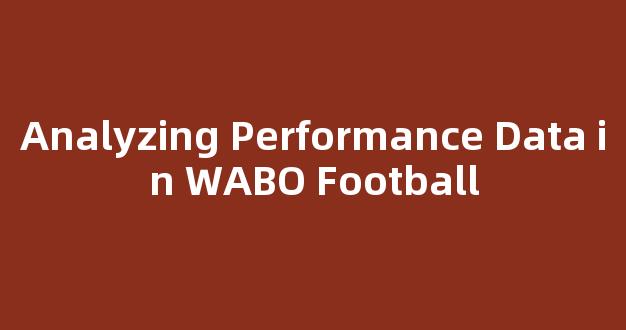## Analyzing Performance Data in WABO Football
In the fast-paced and dynamic world of professional sports, data analysis has become an essential tool for teams seeking to gain a competitive edge. In the realm of football, the use of performance data has revolutionized the way coaches, analysts, and players approach the game. This article will delve into the intricacies of analyzing performance data in WABO football, exploring the various metrics and techniques employed to enhance player performance, optimize strategy, and ultimately achieve success on the field.
### The Role of Data Analysis in WABO Football
Data analysis in WABO football encompasses a wide array of metrics, ranging from basic statistics such as goals, assists, and possession percentages to more advanced measurements like expected goals (xG), passing accuracy, and player movement patterns. By meticulously dissecting these data points, teams can gain valuable insights into individual and team performance, identify areas for improvement, and tailor training regimens to address specific weaknesses. Moreover, the analysis of opponent data enables teams to develop strategic game plans, exploit weaknesses in the opposition, and adapt tactics based on real-time insights.

### Advanced Metrics and Their Impact
One of the most influential aspects of performance data analysis in WABO football is the utilization of advanced metrics. For instance, tracking player movement through GPS technology provides a comprehensive understanding of physical exertion, positioning, and workload management. This data not only aids in injury prevention but also allows coaches to optimize player rotation and substitution strategies. Additionally, the use of xG and expected assists (xA) offers a deeper insight into a player’s attacking contribution, allowing for more nuanced player evaluation beyond traditional statistics.
### Implementing Data-Driven Decisions
The integration of performance data into decision-making processes is crucial for WABO football teams. Coaches and analysts leverage data to make informed choices regarding player selection, formation adjustments, and in-game tactical decisions. Real-time data streams during matches provide immediate feedback, enabling rapid adaptations to maximize performance. Furthermore, the use of predictive modeling based on historical data assists in long-term strategic planning and transfer market activities, ensuring that teams remain competitive in the ever-evolving landscape of football.
### Conclusion
In conclusion, the analysis of performance data has fundamentally reshaped the landscape of WABO football, offering teams a wealth of information to guide their decision-making processes. By leveraging advanced metrics and embracing data-driven methodologies, teams can unlock new levels of performance, gain a competitive advantage, and ultimately achieve success on the pitch. As technology continues to advance, the role of data analysis in football will only grow in significance, shaping the future of the sport and redefining the boundaries of athletic achievement.